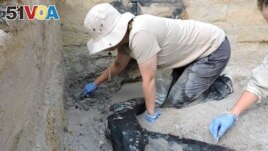26 September 2023
Researchers have found a structure that may be the oldest evidence yet of early humans building with wood.
The structure is simple: two logs, fitted together with a notch.
It is half a million years old. It provides a rare look at how ancient human relatives were working with wood and changing their environments, researchers wrote in a study published recently in Nature.

In this photo provided by researchers, an excavation team uncovers a wooden structure found on a riverbed near a waterfall in Zambia in 2019. (Larry Barham/University of Liverpool via AP)
Larry Barham of the University of Liverpool in Britain was one of the writers of the study. Barham said, "It took me a while before I appreciated what we were looking at." He added about the structure, "It didn't look very nice, to be honest. But it is much more complex than I thought."
Barham and his team dug up the log structure, and several wooden tools, from a riverbed area that sits above a waterfall in the African country of Zambia. They think the crossed logs could have been the base for a bigger structure like a walkway or a platform.
Barham explained that wood usually rots quickly due to the weather. As a result, little evidence remains of how our ancient relatives used the material. But the log structure that researchers found had been below the river's surface, which helped save them.
So when Barham's team found the logs in 2019, they were still able to see signs that early humans had shaped them.
"Everything just looks so fresh, you think, ‘It cannot be this old,'" Barham said.
It was difficult for researchers to estimate the age of the wood structure. Traditional dating techniques could not get deep enough into the past. In this study, researchers used a new method called "luminescence dating."
Luminescence dating uses tiny minerals in the sand to estimate how long materials have been buried, explained study writer Geoff Duller.
Duller is an expert in dating methods at Aberystwyth University in Wales.
The log structure was made at least 476,000 years ago, while the wood tools are slightly younger, under 400,000 years old. That places the materials in a time before our species, Homo sapiens.
The earliest-known Homo sapiens bones date from roughly 300,000 years ago in Morocco. The Kalambo Falls logs were determined to be from about 476,000 years ago.
The objects would have been made by another kind of early human relative — possibly Homo heidelbergensis, which was around in Africa at the time, the study's writers said.
Homo heidelbergensis had a bigger braincase and flatter face than earlier hominins - species on the human evolutionary lineage.
If these ancient humans were putting effort into building these structures, it suggests they may have stayed for a while or made repeated visits. In other words, they were not just groups of hunter-gatherers, said Dirk Leder of Germany's Lower Saxony State Office for Cultural Heritage. Leder was not involved with the research.
Annemieke Milks of Britain's University of Reading was also not involved in the study. Milks said about the finding, "It's an important window into what these humans were capable of."
I'm John Russell.
Maddie Burakoff reported on this story for the Associated Press. John Russell adapted it for VOA Learning English.
____________________________________________
Words in This Story
notch – n. a small cut that is shaped like a V
appreciate – v. to understand the worth or importance of something
platform -- n. a flat surface that is raised higher than the floor or ground
rot – v. to slowly decay
species -- n. a group of animals or plants that are similar and can produce young animals or plants
lineage – n. a chain of species each of which is considered to have evolved from one before